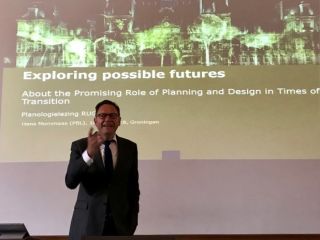‘Planners of the world unite!'
| Date: | 28 May 2018 |
| Author: | Brandt de Vries |

Public spatial planning lecture by Hans Mommaas, general director of the PBL. Exploring possible futures, about the promising role of planning and design in times of transition - 18th of May 2018
Accompanied by an audience of around 50 students and researchers from the faculty of spatial sciences, prof. dr. ir. Hans Mommaas gave an inspiring lecture on his ideas about the role of planning in times of transition. He started with his conclusion and central message: ‘Planners of the world unite!’. The future planners in the audience are much needed in the transitions society faces. Not because of the challenges of these transitions, but rather because of the opportunities that lie at the center of each transition.
According to Mommaas, we all know what the ‘good life’ is. People know what they want in the short term, but they also want to leave a sustainable planet for their children in the long term. He defined four major transitions in the near future: climate and energy, food, agriculture and nature, circular economy and liveable and strong urban regions. These transitions have to be included in a new planning tradition, in which planners need to be collective inventors. They need to combine knowledge production with the practical application of knowledge, and processes of learning, exploring, connecting and communicating.
Giving directions to these transitions is valuable for governments. In time of transition one might think governments should change as well, however Mommaas takes another perspective. It is not so much about reorganizing governments, but about taking new ways of communicating. Both within different layers of the government as well as between governments and societal parties. The transitions Mommaas talks about, take place in our daily life. Making people co-owners of challenges and solutions should become the new paradigm for a communicative government. Therefore, partnerships are crucial in policy creation and implementation.
The PBL brings environmental knowledge to the government and planning processes. They bring data from different national monitoring agencies together, analyze these and give meaning to it. Mostly communicated in reports on topics related to spatial development and the environment, but also through communication and media, PBL tries to target and distribute the knowledge on a global, national, regional and local scale. In the communicative and explorative transitions, the task of assessing and distributing information is getting ever more important. Especially, because the audience is broadening, the PBL should no longer only reach politicians but all the parties that participate in the policy making process.
Mommaas concluded how he started, with the message: planners in the world unite! Unite and use planning as a bridge, between knowledge, imagination and involvement, between here and there, between now and the future, between top down and bottom up, between systems and the outside world, and between data and practice. Unite and facilitate the collective inventions a world in transition needs. During the discussion after the lecture it turned out to be hard to argue against (t)his passionate vision.
Download the presentation slides as pdf
It was a great honour to have Hans Mommaas in Groningen. For the people who joined the lecture, thanks for coming. For all others, see you at the next Planologielezing!

